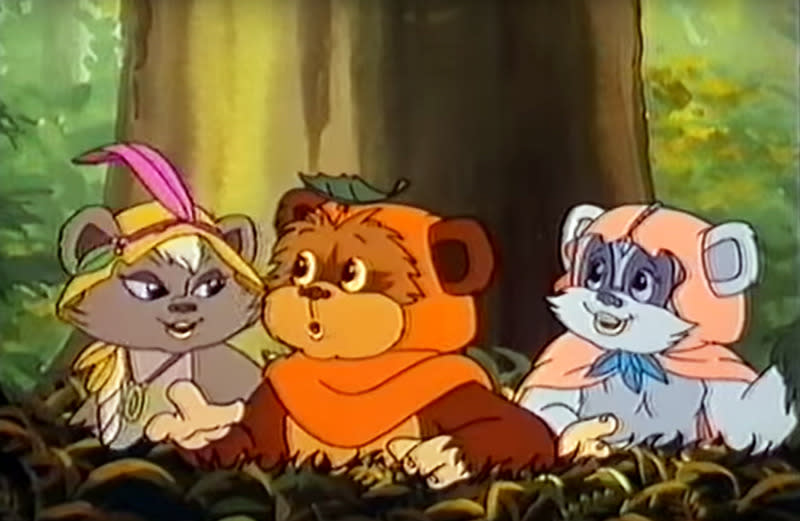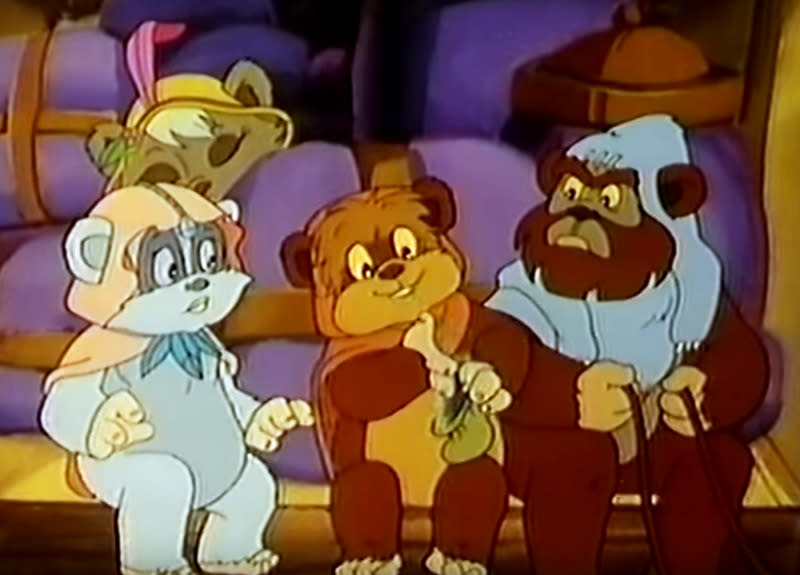'Star Wars': How 'Ewoks' and 'Droids' Arrived on Saturday Morning TV

With the hotly-anticipated Star Wars: The Force Awakens now in theaters, the Force is extra-strong with one of the biggest film franchises around. Of course Star Wars isn’t confined to the big screen; fans can spend time in George Lucas’s galaxy in novels, comic books and Disney XD’s popular animated series Star Wars Rebels. That show is the latest entry in a long history of Star Wars cartoons that dates back to the mid-‘80s, after the release of Return of the Jedi put a button on the original trilogy.
Related: How the Ewoks Came to TV 31 Years Ago
Around the same time that Lucas was exploring the franchise’s television opportunities with two made-for-TV movies starring Jedi’s breakout forest critters, the Ewoks, he sold ABC on a pair of cartoons for their Saturday morning line-up: Ewoks and Droids. The latter followed everyone’s favorite robot twosome, C-3PO (voiced, as always, by Anthony Daniels) and R2-D2, on their various adventures before the events of A New Hope. Ewoks, meanwhile, unfolded on Endor in the years before Luke and Leia showed up on their mission to blow up the second Death Star.
Back in the mid-‘80s, being able to wake up on Saturday mornings and watch new animated adventures in the Star Wars universe was a novelty for fans. These days, though, neither show is part of official Star Wars continuity, and, in fact, are completely out of print. But they still represent a fascinating period in the franchise’s history, when Star Wars was exploring opportunities beyond the big screen.

Paul Dini, one of the creative forces behind some of TV’s all-time greatest animated series — including Tiny Toon Adventures, Batman: The Animated Series and Batman Beyond — as well as an established comic book author (his latest graphic novel, Dark Knight: A True Batman Story, will be released next year), was a key figure in the Ewoks writers’ room. By the time the series drew to a close, he had written 14 out of the 35 produced episodes, and contributed a teleplay to Droids as well. Yahoo TV spoke with Dini about launching the earliest Star Wars cartoon series, which characters that could (and couldn’t) appear on Ewoks and Droids, and the Ewok cameo he wanted to include in the Clone Wars animated series.
Ewoks is among your earliest writing credits on an animated series. Was it a dream of yours to write for Star Wars?
Oh, of course. I loved Star Wars; I saw the first movie when I was 18, and was a huge geek from that moment on. It was a great time to be at Lucasfilm in the mid-‘80s; besides Star Wars, there was Indiana Jones and other tremendous movies being made. And [Pixar founder] John Lasseter was in the next building over animating blobs and squiggles and stuff. I would go over there and watch what he was doing, and knew it would be huge someday. They were very generous with the artwork and props; you could check out early Ralph McQuarrie Star Wars concept paintings [from the archives] and display them in your office. I also had the Mummy case from Raiders of the Lost Ark outside my office, and the fertility idol as a paperweight on my desk. And being entrusted with the next phase of Star Wars was terrific. It was a challenge to go in and say, “Let’s make it the best show we can and give it its own energy and mythology.”
What was the guiding idea behind Star Wars’ next phase at that point?
George was coming off Return of the Jedi and had basically said he was done with Star Wars because he wanted to make different types of films. But they wanted to keep Star Wars alive in different forms through licensing, publishing and animation. Back then, Saturday morning television was really the only game in town for animation, so he [struck a deal] with ABC for two shows: Droids and Ewoks. The series would be set in the Star Wars universe, but didn’t really have to tie into the main story. So there’d be no Luke, no Leia and no Empire to speak of. I think George looked at Droids as being the series that would interest older boys, and Ewoks was going to appeal to younger kids. He didn’t want to do basic Saturday morning stories, but at that point, nobody had really come along that could challenge what was being done in animated storytelling. It would be about another ten years before that happened.
Did you have a choice of which show you wanted to work on, or were you assigned to Ewoks?
They were more interested in me for Ewoks and I was as well. I felt it was a better fit for me, because the stories were about family and sibling rivalry and being the littlest one in a group of older warriors. It was the kind of family soap opera that George is fond of referring to Star Wars as being. Droids didn’t have those elements; it was focused on the two droids, C-3PO and R2-D2, and only one of them really talks! And if you’re going to have a show that centers heavily around Artoo, the animation and pantomime has got to be top-notch. You can do something like it today with Wall-E, but we were 20 years away from that.

Aside from not being able to use characters from the original trilogy, were you mostly given the creative freedom to tell your own stories? In many ways, Ewoks plays more like fantasy than science fiction.
We had the freedom and support of George and Lucasfilm to take the Ewoks and develop them into something else, and not adhere to what they were in the movies. Because how could we do that? All the dialogue would have to be subtitled! In my first meeting with George, one of the things we kept coming back to was that the Ewoks would have a sense of community and continuity. That was also around the time that George was heavily into fantasy. He was working on Willow and Labyrinth, so he was looking at a looking at a lot of inspirations for those two movies. I had also seen early Hayao Miyazaki movies like Castle in the Sky around that time and loved them. And Joe Johnston had created these creatures called Duloks for a Return of the Jedi spin-off story, which gave us a great group of villains to use. In the mid-‘80s, the characters were mainly dormant, so the attitude [at Lucasfilm] was almost, “If you want to do something with them, great! We don’t want to do Luke, Leia and Han, but if you want to do any of the others, that’s fine with us because we basically want to keep these characters alive in some form.”
You did eventually sneak the Empire into one of the final episodes, “Battle for the Sunstar.” Would you have done more of that had the series continued?
We were coming to the end of our order and knew we probably wouldn’t be back, so we said, “Let’s do one with the Empire in it,” and George was willing to go along with it. Had we done more, I think there might have been more of that. I would have loved to have brought Luke or Leia in. Leia seemed to have a great rapport with the Ewoks in Jedi, so if we could have had a couple of Luke and Leia stories on Endor, that would have been awesome. And Darth Vader would have been great to use as well.
Ewoks at least lasted two seasons, whereas Droids only ran for 13 episodes.
I think Ewoks fit the paradigm of what ABC was looking for as a Saturday morning cartoon. The characters were softer and more child-appealing. Droids was also more of hard sell because of what George wanted the show to be. He really wanted Artoo and Threepio to be vagabonds going from master to master, just trying to find their place in the universe.
Prior to the recent jettisoning of the Expanded Universe, did Lucasfilm consider Ewoks to be part of Star Wars canon?
If the show had run a few more years, than definitely. As it is, I think it’s remembered as a fond experiment of that time. There were some elements of their world that made it into other books and things, but other than that, I don’t think it endured. The shows were good for their time, and took some chances creatively and artistically, but if you put them alongside something like The Clone Wars, they kind of pale in comparison.
You contributed several scripts to The Clone Wars during that cartoon’s run. How did the experience differ from Ewoks?
Ironically, I wound up working more with George on Clone Wars; apparently, he was in the writers’ room a lot there. He was available during Ewoks if we needed to run ideas by him, but his time was more limited. With The Clone Wars, he loved getting in and working on individual episodes, making them the mini-movies he’d always wanted to do about the Star Wars universe. Also, the restrictions were off. With Ewoks, we always had to dance around the violence issues of Saturday morning TV. On Clone Wars, we’d be thinking about how to solve the problem of a villain holding Obi-Wan’s old love at gunpoint, and George would just say, “Anakin comes up from behind and runs a lightsaber through him.” And we’d be like, “Yeah, let’s do that!” [Laughs] Ewoks and Droids were much softer because that’s what the time and the network demanded.
At the time and still today, the Ewoks are reviled by a certain segment of Star Wars fandom. Was part of the fun of doing an Ewoks show trying to prove that these characters could be really interesting?
Yeah, I think there was a chance to take them and make them into something else. When I was working on Clone Wars, I remember having this idea that you’d have Ahsoka and Anakin looking for a rogue bounty hunter to take them someplace. They go into this bar and they’re for the toughest guy. They see this huge mountain of a creature stand up and confront them and he points over his shoulder and sitting there is an Ewok just sharpening a spear. Like, “That’s the guy you want.” [Laughs] Just really get into them and make them a little badass; like, this Ewok got off planet somehow and he’s making his way as a bounty hunter. I remember trying to pitch some element of that during Clone Wars, but I think they wanted to keep them based on Endor. They kind are what they are: surrogates for innocent people.


